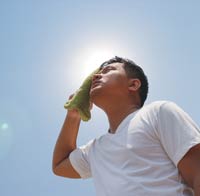
Fun in the Sun? Not Always
One of your biggest risk management challenges during the summer appears every day at about 5:30 a.m. and lasts until about 8 p.m. — it’s the sun.
“There are more new skin cancer diagnoses each year in the United States than breast, prostate, lung and colon cancers combined, with one person dying from skin cancer every hour,” observes Kyle Saros, PDRMA Risk Management Consultant. “And heat kills more than 600 people annually. You need to take sun and heat threats seriously to protect your employees and patrons!”
Heat exhaustion or heat stroke occur when you overload the body’s temperature control system during very hot, high-humidity weather, and sweating alone can’t cool the body. “You and your staff also should be aware that personal factors — such as being old, young (zero-to-4 years old), obese or suffering from heart disease, mental illness, prescription drugs or alcohol — are more likely to interfere with body-temperature regulation,” Saros adds. Heat exhaustion or heatstroke can even cause brain damage and injure other vital organs.
 What Is Heat Exhaustion? What Is Heat Exhaustion?
Heat exhaustion can develop after several days of exposure to high temperatures and inadequate or unbalanced hydration. Those most prone to heat exhaustion are the elderly and those with high blood pressure.
“But if you work in a hot environment — which is often the case for agency employees at aquatic facilities, golf programs, maintenance and summer camps — you’re also more prone to heat exhaustion,” explains Saros. Watch for these signs:
- Heavy sweating.
- Paleness.
- Muscle cramps.
- Tiredness.
- Weakness.
|
- Dizziness.
- Headache
- Nausea or vomiting.
- Fainting.
|
Also check for cool, moist skin, a fast and weak pulse as well as fast and shallow breathing. Seek medical attention if symptoms worsen or last longer than one hour. Without treatment, heat exhaustion can progress to heat stroke, so do the following to lower body temperature:
- Drink cool, nonalcoholic beverages.
- Rest.
- Take a cool shower, bath or sponge bath.
- Move to an air-conditioned environment.
- Wear lightweight clothing.
- Remember to eat regularly and consume foods that are 90-to-95-percent water such as leafy greens, melon, celery, broccoli, tomatoes and berries.
What Is Heat Stroke?
With heat stroke, the body’s temperature can rise to 106°F or higher within 10 to 15 minutes. Heat stroke causes a cascading series of bodily failures including dizziness, nausea, confusion and cell death. If you do not lower the body’s temperature quickly, there can be lasting damage to the brain, nervous system and vital organs. Warning signs vary but include:
- Extremely high body temperature (above 103°F).
- Red, hot and dry skin (no sweating).
- Rapid, strong pulse.
- Throbbing headache.
|
- Dizziness.
- Nausea.
- Confusion.
- Unconsciousness.
|
“Heat stroke can be a life-threatening emergency,” emphasizes Saros. “If you see someone with any heat stroke warning signs, call immediately for medical assistance while you begin cooling the victim.”
- Get the victim to a shady area.
- Cool the victim rapidly, using whatever methods you can. Immerse them in a tub of cool water; place them in a cool shower; spray them with cool water from a garden hose; sponge them with cool water; or if humidity is low, wrap them in a cool, wet sheet and fan them vigorously.
- Monitor body temperature and continue cooling efforts until body temperature drops to 101-102°F.
- If there’s a delay in emergency medical personnel reaching the victim, call the hospital emergency room for further instructions.
- Do not give the victim alcohol to drink.
- Get medical assistance as soon as possible.
Protect Yourself from Heat and Sun

- Stay cool, hydrated (drink 8 ounces of water every 15-20 minutes) and informed about how to protect yourself: find air conditioning during hot hours, wear cool clothing, sunglasses with a UV 400 rating or “100% UV protection” on the label and wear broad rim hats.
- Apply a broad-spectrum sunscreen with SPF value of 15 or higher regularly, as directed. Reapply sunscreen at least every two hours and more often if swimming or sweating.
For more information about sun and heat risks as well as resources available to your agency, download these PDRMA resources from our website:
Heat Index and Heat Disorders Guide (261).
Sun Exposure Precautions (899).
Guidelines for Conducting Summer School Sports Programs (1595).
Heat Stress for Public Employees — Seeing Red — Video (English/Spanish). |